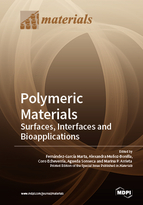Polymeric Materials: Surfaces, Interfaces and Bioapplications
A special issue of Materials (ISSN 1996-1944).
Deadline for manuscript submissions: closed (30 November 2018) | Viewed by 118888
Special Issue Editors
Interests: polymer chemistry; synthesis and modification of polymers; antimicrobial polymers; active surfaces; material characterization
Special Issues, Collections and Topics in MDPI journals
Interests: food packaging; biobased and/or biodegradable polymers; nanocomposites; active materials; waste valorization; mechanical recycling; compostability.
Special Issues, Collections and Topics in MDPI journals
Interests: polymer coatings; antimicrobial coatings; biointerfaces; porous surfaces; functional surfaces superhydrophobicity; bioapplications
Special Issues, Collections and Topics in MDPI journals
Interests: polymeric micro/nanogels; smart polymers; antimicrobial polymers, rheology; cellulosic liquid crystalline polymers; natural polymers, electrospinning
Special Issues, Collections and Topics in MDPI journals
Interests: green polymer chemistry; enzymatic catalysis; biobased polymers; shape memory polymers; (nano)composites
Special Issues, Collections and Topics in MDPI journals
Special Issue Information
Dear Colleagues,
Polymeric materials—either synthetic or natural—play an essential role in everyday life, especially those dedicated to bioapplications, such as medical devices, implants, drug delivery systems, active food packaging, agricultural films for farming and crop protection, biosensors, or bioremediation, among others.
This Special Issue aims to cover all the aspects related to recent innovations on surfaces, interfaces, and bioapplications of polymeric materials. Special emphasis will be placed on the influence of chemical or physical surface modification on the inferred properties, such as wettability, stimuli-responsiveness, compatibility, adhesion, toxicity, etc. Besides, contributions analyzing the effect of interfaces and interphases of polymeric blends, hybrids, or (nano)composites on their physico-chemical and biological properties are also appreciated. We also intend to include functional and protective coatings as well as thin films for biological applications in this Special Issue. Finally, we would like to emphasize that this Special Issue is widely inclusive, so we expect a large number of works to fall within its scope.
Therefore, it is our pleasure to invite you to submit a manuscript for this Special Issue. Full papers, communications, and reviews are all welcome.
Dr. Marta Fernández-García
Dr. Alexandra Muñoz-Bonilla
Dr. Marina P. Arrieta
Dr. Coro Echeverria Zabala
Dr. Agueda Sonseca Olalla
Guest Editors
Manuscript Submission Information
Manuscripts should be submitted online at www.mdpi.com by registering and logging in to this website. Once you are registered, click here to go to the submission form. Manuscripts can be submitted until the deadline. All submissions that pass pre-check are peer-reviewed. Accepted papers will be published continuously in the journal (as soon as accepted) and will be listed together on the special issue website. Research articles, review articles as well as short communications are invited. For planned papers, a title and short abstract (about 100 words) can be sent to the Editorial Office for announcement on this website.
Submitted manuscripts should not have been published previously, nor be under consideration for publication elsewhere (except conference proceedings papers). All manuscripts are thoroughly refereed through a single-blind peer-review process. A guide for authors and other relevant information for submission of manuscripts is available on the Instructions for Authors page. Materials is an international peer-reviewed open access semimonthly journal published by MDPI.
Please visit the Instructions for Authors page before submitting a manuscript. The Article Processing Charge (APC) for publication in this open access journal is 2600 CHF (Swiss Francs). Submitted papers should be well formatted and use good English. Authors may use MDPI's English editing service prior to publication or during author revisions.
Keywords
- Surface modification/functionalization
- Surface segregation
- Micro- and nanopatterned films
- Blends and (nano)composites
- Coatings
- Surface wettability
- Stimuli-responsive materials/smart surfaces
- Bioapplications











